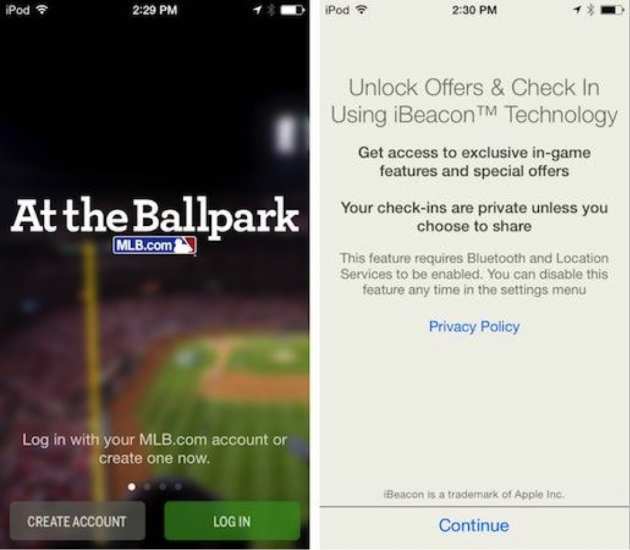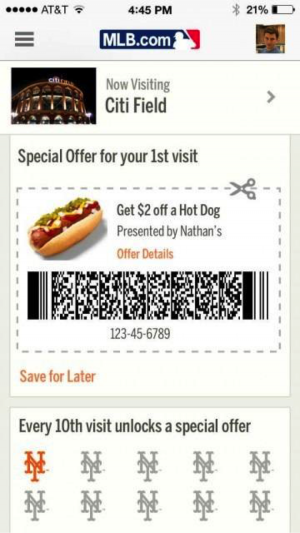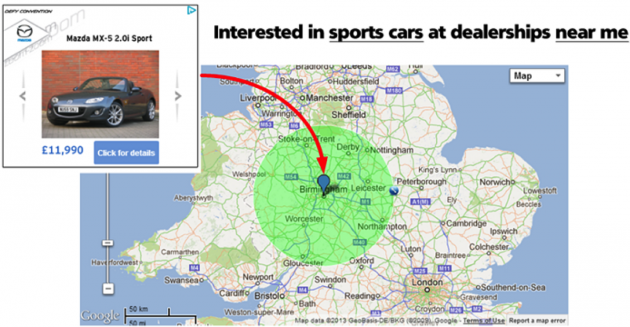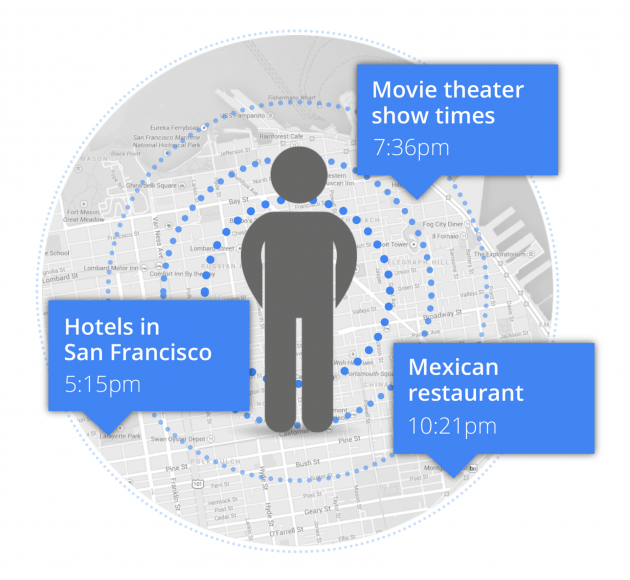How Geographical Targeting Can Supercharge Your Marketing

Today's guest post comes from digital marketing strategist Tracy Vides. Enjoy!
What’s the best way to pinpoint your target audience? Geographical targeting, arguably. Most new web/app development and ecommerce platforms allow you to target content to visitors based on their geographical location. Geo-targeting can boost the effectiveness of nearly every digital marketing channel, from organic search to website optimization, from social media to email marketing.
And why not? Google is the new yellow pages, they say! With people looking for on-demand products and services on the go, geo-targeting is increasingly central to the existence of local businesses like restaurants as well as regional professional service providers. Geo-targeting also helps national businesses encourage audiences in a particular region or market to take specific actions based on tactical goals, such as attending an event at a local branch.
20% of all PC search queries and nearly 50% of all mobile search queries carry local intent, meaning the searcher is expecting to see businesses and service providers near her in the results.
Source: Think with Google
Therefore, mastering geo-targeting is not something you should relegate to your “wishful thinking” list. To know exactly what’s in store for you with geo-targeting, here are some handpicked geo-targeting success stories just for you.
Going beyond local traffic with geo-targeting
When you think geo-targeting, somehow the automatic assumption is that you only want to target people within a pre-defined geographic area. Indeed, most PPC campaigns are structured in a way that include or exclude specific cities or states. But that does not have to be the only way your campaigns are designed.
Seer Interactive, an SEO and PPC agency, retells their experience with a client who wanted to address customers in specific cities in the US. However, they did not want to miss out on potential customers who lived outside the target city right now but were planning to move to or travel to the target cities.
So the agency decided to take a creative route instead. They picked the whole of the United States as their geo-targeting region and then got busy with various combinations of open-ended Modified Broad Match keywords for each campaign like ‘+from +New +York +to’ or ‘+cheap +flights +to +New +York’.
By building similar campaigns for locations like New York, Los Angeles, and Chicago, the agency was able to achieve an ROI of 231% and brought in incremental revenues of $15,000 in just a month and a half.
Using iBeacons to grow engagement
One of the most exciting new uses of geo-targeting has been in the offline space. Beacons are part of NFC (Near Field Communication) technology implementations, which allow brands to communicate hyper-targeted offers to consumers carrying smartphones inside stores, theaters, malls or other such venues via Bluetooth (low-energy).
To take advantage of NFC, a retail location must have active physical beacons within its premises. These beacons pair up with specific apps on users’ smartphones. When a user comes within range of a beacon, the app can send custom push notifications to the user.
Since support for iBeacons is built into iOS7 and the latest iPhones, there’s a readymade target market for retailers and brands wanting to adopt this targeting technology.
One of the biggest names in the iBeacon horizon today is Major League Baseball. Of the 30 stadiums that are under the MLB, 28 now offer iBeacon services. Baseball fans who have downloaded MLB’s award-winning Ballpark app don’t just receive score updates or match highlights videos but are proactively offered services on their iPhones as soon as they come within range of an MLB stadium.

MLB's mobile app serves up highly-targeted offers to smartphone users.
When a Ballpark app user approaches any of the iBeacon-enabled stadiums on game day, they start receiving updates and information about the game and related trivia. Users can enter by displaying the barcode for their ticket that surfaces automatically on the app and find directions to their seats on the app via the iBeacon. The technology also allows stadiums to pass special deals and offers for merchandise or concessions.

MLB app users get special offers for concessions and more.
The move seems to have been really popular with baseball fans overall. The San Francisco Giants fans who use the app and the iBeacon technology ended up way more engaged and spent 93 percent more than regular users.
Finding success (read: sales) with new technology is one thing, and tracking analytics, pinpointing causes for wins and losses, and integrating processes into future campaigns is totally another. In addition to hardware like beacons and POS systems, you need robust ecommerce SaaS platforms like Shopify to complete the mix. This allows you to integrate your web/mobile merchandising and your marketing, whether you’re a global retailer or a regional sports club.
Dynamic personalization of ads with geo-targeting
It’s not enough to just target users in specific locations with geo-targeted ads and offers. All geo-targeted ads must also carry ad copy and creative that are tailor-made for the location. Make sure you have a base set of ads made for each region you’re targeting and then take it up a notch by dynamically customizing them for your users’ precise location when the campaign runs.
Mazda realized that car buyers do not travel beyond a certain maximum radius around their homes to visit dealerships and look for new cars. Armed with data on specific locations that they wanted to maximize revenues for, Mazda set up dynamically personalized mobile ads that would be triggered every time the user entered the radius of a local Mazda dealership.
The ads were designed to dynamically update details about the car model to be advertised based on the users’ likes and past browsing behavior. The dealerships that the ads linked to were selected based on the users’ geographical proximity to their location.

Mazda's used personalized ads for customers within a certain radius of a dealership.
The results Mazda got were spectacular. 20% of all targeted consumers interacted with the dynamic ad. The ones who saw or interacted with the ads were 53% more likely to make an inquiry at their local Mazda dealership. What’s more, revenues through these geo-targeted display ads grew 98% higher than the sales achieved by other platforms.
Geo-fencing with mobile ads
Geo-fencing is a sub-tactic within geo-targeting where users are identified within very specific geographical areas based on their GPS coordinates. Promotional messages can be communicated to users who enter the coordinates set up by a geo-fence on their mobile devices.
The drawback with geo-fencing is the fact that it operates on GPS. Many smartphone users turn their GPS off to avoid draining their battery. Nevertheless, geo-fencing reduces the barriers to entry for brands that want to consider proximity targeting at physical locations.
Domino’s Pizza turned to geo-fencing to reach hotel guests and make the process of ordering easier for them. The idea is to go one-up on room service or restaurants that operate inside hotels and offer hotel guests the option of a cheap and quick meal without having to hunt for the nearest pizza place.
Domino’s started by geo-fencing a range of hotels across South Florida by specifying their exact GPS coordinates. When guests checked into these hotels, they were greeted by special coupons and deals meant specifically for that location. When guests clicked on the ad or coupon, they were taken to a landing page that carried menus and direct ordering options. What a great way to meet users' needs at the proverbial right moment and right place!
Needless to say, the campaign has met with immediate success. And consequently, we can expect more such tactics from competing brands in the not-too-distant future.
Over to you
What has your experience been in targeting users by location? How do you walk the tightrope between giving users what they need exactly when they need it and sending them pushy messages likely to irritate them or even creep them out? Have you tried anything radically different that you’d like to share with our readers?
Tell us your experience on Twitter @usertesting.
Insights that drive innovation
Get our best human insight resources delivered right to your inbox every month. As a bonus, we'll send you our latest industry report: When business is human, insights drive innovation.
Tracy Vides is a digital marketing strategist who works with small businesses and startups to help improve their content, SEO, and social presence. Tracy is also a prolific writer at Study Clerk—her posts on ecommerce, social media, and conversion are regularly featured on tech blogs across the web.







